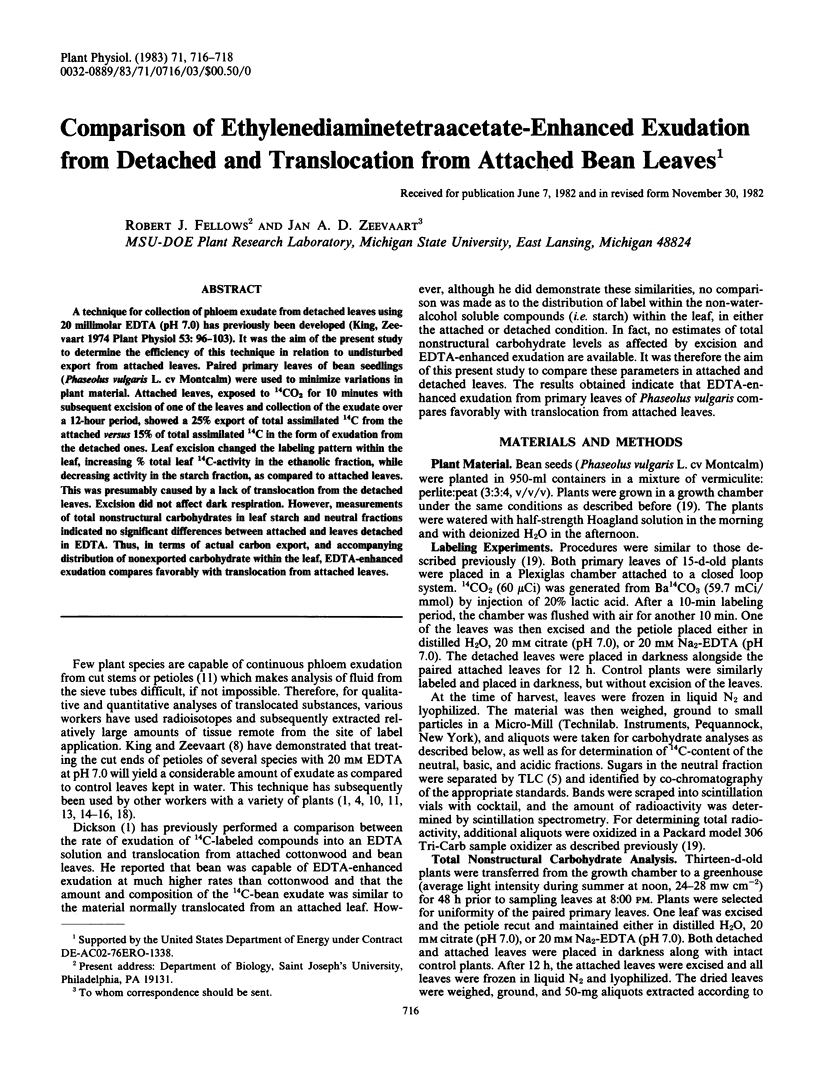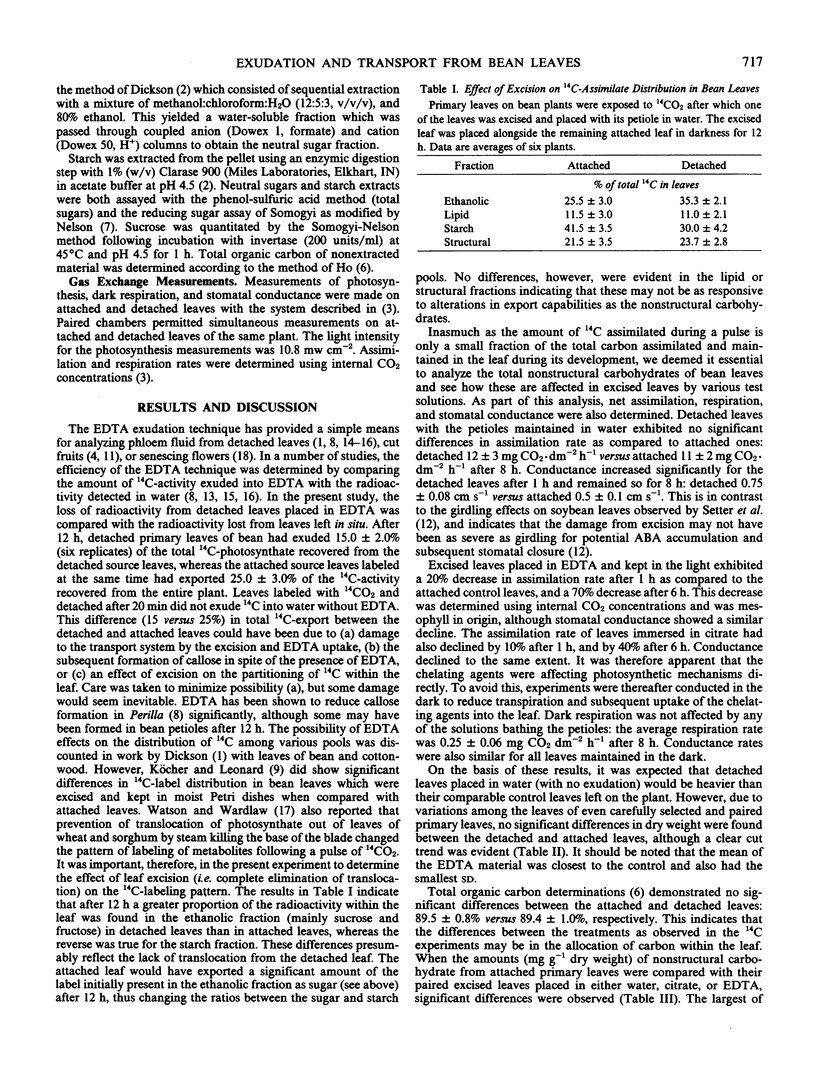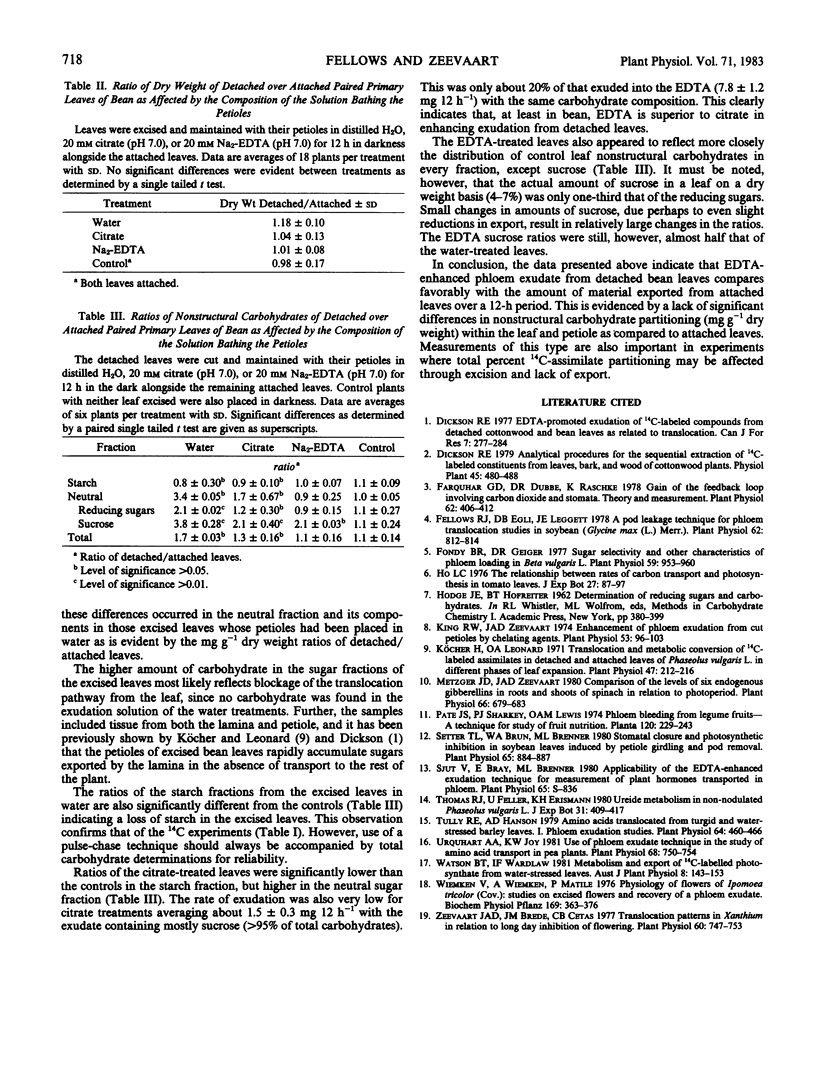Abstract
A technique for collection of phloem exudate from detached leaves using 20 millimolar EDTA (pH 7.0) has previously been developed (King, Zeevaart 1974 Plant Physiol 53: 96-103). It was the aim of the present study to determine the efficiency of this technique in relation to undisturbed export from attached leaves. Paired primary leaves of bean seedlings (Phaseolus vulgaris L. cv Montcalm) were used to minimize variations in plant material. Attached leaves, exposed to 14CO2 for 10 minutes with subsequent excision of one of the leaves and collection of the exudate over a 12-hour period, showed a 25% export of total assimilated 14C from the attached versus 15% of total assimilated 14C in the form of exudation from the detached ones. Leaf excision changed the labeling pattern within the leaf, increasing% total leaf 14C-activity in the ethanolic fraction, while decreasing activity in the starch fraction, as compared to attached leaves. This was presumably caused by a lack of translocation from the detached leaves. Excision did not affect dark respiration. However, measurements of total nonstructural carbohydrates in leaf starch and neutral fractions indicated no significant differences between attached and leaves detached in EDTA. Thus, in terms of actual carbon export, and accompanying distribution of nonexported carbohydrate within the leaf, EDTA-enhanced exudation compares favorably with translocation from attached leaves.
Full text
PDF


Selected References
These references are in PubMed. This may not be the complete list of references from this article.
- Farquhar G. D., Dubbe D. R., Raschke K. Gain of the feedback loop involving carbon dioxide and stomata: theory and measurement. Plant Physiol. 1978 Sep;62(3):406–412. doi: 10.1104/pp.62.3.406. [DOI] [PMC free article] [PubMed] [Google Scholar]
- Fellows R. J., Egli D. B., Leggett J. E. A Pod Leakage Technique for Phloem Translocation Studies in Soybean (Glycine max [L.] Merr.). Plant Physiol. 1978 Nov;62(5):812–814. doi: 10.1104/pp.62.5.812. [DOI] [PMC free article] [PubMed] [Google Scholar]
- Fondy B. R., Geiger D. R. Sugar Selectivity and Other Characteristics of Phloem Loading in Beta vulgaris L. Plant Physiol. 1977 May;59(5):953–960. doi: 10.1104/pp.59.5.953. [DOI] [PMC free article] [PubMed] [Google Scholar]
- King R. W., Zeevaart J. A. Enhancement of Phloem exudation from cut petioles by chelating agents. Plant Physiol. 1974 Jan;53(1):96–103. doi: 10.1104/pp.53.1.96. [DOI] [PMC free article] [PubMed] [Google Scholar]
- Köcher H., Leonard O. A. Translocation and Metabolic Conversion of C-Labeled Assimilates in Detached and Attached Leaves of Phaseolus vulgaris L. in Different Phases of Leaf Expansion. Plant Physiol. 1971 Feb;47(2):212–216. doi: 10.1104/pp.47.2.212. [DOI] [PMC free article] [PubMed] [Google Scholar]
- Metzger J. D., Zeevaart J. A. Comparison of the levels of six endogenous gibberellins in roots and shoots of spinach in relation to photoperiod. Plant Physiol. 1980 Oct;66(4):679–683. doi: 10.1104/pp.66.4.679. [DOI] [PMC free article] [PubMed] [Google Scholar]
- Setter T. L., Brun W. A. Stomatal closure and photosynthetic inhibition in soybean leaves induced by petiole girdling and pod removal. Plant Physiol. 1980 May;65(5):884–887. doi: 10.1104/pp.65.5.884. [DOI] [PMC free article] [PubMed] [Google Scholar]
- Tully R. E., Hanson A. D. Amino Acids Translocated from Turgid and Water-stressed Barley Leaves: I. Phloem Exudation Studies. Plant Physiol. 1979 Sep;64(3):460–466. doi: 10.1104/pp.64.3.460. [DOI] [PMC free article] [PubMed] [Google Scholar]
- Urquhart A. A., Joy K. W. Use of Phloem exudate technique in the study of amino Acid transport in pea plants. Plant Physiol. 1981 Sep;68(3):750–754. doi: 10.1104/pp.68.3.750. [DOI] [PMC free article] [PubMed] [Google Scholar]
- Zeevaart J. A., Brede J. M., Cetas C. B. Translocation patterns in xanthium in relation to long day inhibition of flowering. Plant Physiol. 1977 Nov;60(5):747–753. doi: 10.1104/pp.60.5.747. [DOI] [PMC free article] [PubMed] [Google Scholar]


